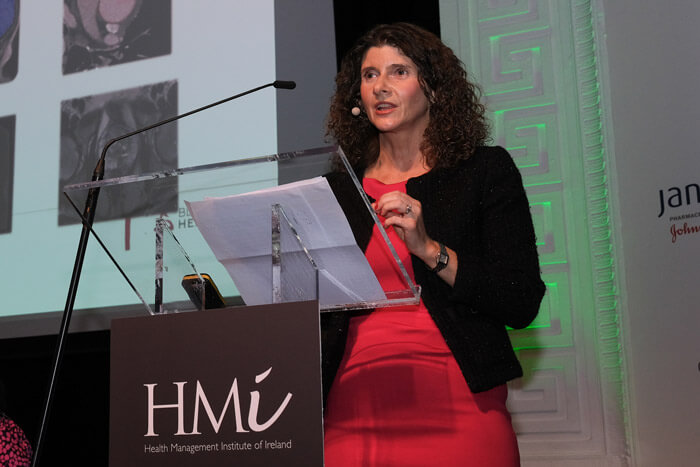
The Private Hospitals Association believed a strategic partnership with the public sector would serve this nation much better than the current reactive approach, Dr. Caroline Whelan, Group CEO, Blackrock Health Group, (Blackrock Clinic, Hermitage Clinic, Galway Clinic and Limerick Clinic), told the Conference.
It required leadership at every level to drive a better model – local delivery, value for money, utilising all access, putting patients first and moving beyond capacity to true engagement.”
She said partnership worked as we learned from the pandemic. “Public, private, academia and industry must work together to meet the challenges of the coming decade. The development of public strategy is self limiting if the skills, innovation, efficiencies capabilities and capacity of the private sector and industry are not considered in planning. We all have a responsibility to reach out across the sectoral divide to align, amplify and accelerate partnership to deliver value based healthcare and improved health outcomes”.
Dr. Whelan was speaking on “Engagement & Technology: Keys To Successful Integration.”
She said that private hospitals in Ireland collaboratively provided c.2,600 beds (including day beds) to the Irish health care system. (2020). There was a concentration of private hospitals in Dublin, which accounted for c. 52.7% of private beds.
The Blackrock Group in Dublin & Galway provided 438 beds, had 600 Consultants and 2,036 staff . The Bons Secours Group in Dublin, Cork, Galway, Limerick and Kerry had 843 beds. 450 Consultants and 3,388 staff. The Beacon Hospital in Dublin had 200 beds, 300 Consultants and 1,400 beds. The Sports Surgery Clinic in Dublin had 83 beds, 40 Consultants and 370 staff. St John of God Hospital in Dublin had 182 beds and 441 staff. The UPMC Group in Waterford, Kilkenny & Kildare had 198 beds, 150 Consultants and 654 staff. The Mater Private Group in Dublin & Cork had 281 beds, 300 Consultants and 1,513 beds. St Vincent’s Private Hospital in Dublin had 236 beds and 968 staff. The Charter Medical Private Hospital in Westmeath had 77 beds and Kingsbridge Hospital in Sligo had 19 beds and 300 staff.
Backrock Health had more ICU beds (28) and operating theatres (24) than any other private hospital group.
Dr. Whelan said the private hospital sector carried out 300,000 Theatre procedures and 3 million diagnostic tests, annually. It provided 1 in 5 hospital beds with c. 1 million bed nights available per year. It had 8,100 healthcare professionals, c.2,500 GPs referred patients into the sector and over half of all spinal and cardiac procedures were carried out in the private sector.
Looking at Patient Confidence in the private sector, Dr. Whelan said 2.44 million people were insured with inpatient health insurance plans at the end December 2022 This was an increase of 3% over the previous 12 months. The market had exceeded the levels of the previous peak of 2.3 million people at end of 2008. In addition to inpatient plans, an additional 105,000 people were insured with products solely providing outpatient benefits or health insurance cash plans. CSO population estimates indicated 47.6% of the population held inpatient health insurance plans. “Public confidence in the sector remains high despite the enduring cost of living crisis and increasing premium prices. The sector has had a strong performance on introduction of innovative technologies and processes”
Dr. Whelan said public health spend in Ireland was only 6.1% of GDP, down from 7.1% in 2020. Compared to other European countries we ranked low – Germany 12.8% GDP, France & Austria 12% and the UK 11.9%.
Dr. Whelan said the Health Information landscape in Ireland was highly fragmented, ‘siloised,’ with insufficient formal co-ordination It was collected by multiple organisations and individuals, was in different places, there were varying standards of quality, lack of interoperability (linkage) – an inability to share/ connect and no unique individual patient/health identifier in use.
There were a number of measures required. They were:
• A fundamental culture change and resources commitment around accessing, resourcing and using health data – personal online data stores would grow in the next decade
• Use of health data for the public interest should be the overarching tenet of a publicly funded health system
• Implementation of IHI to link data sets
• National strategy for data sharing – sector wide guidance underpinned by legislation for secondary use (good example during COVID – information in the right hands, at the right time and available in an understandable manner)
• Specific legislation around collection, use and sharing that is GDPR compliant
• Roll out e-health strategy
• Cross sector partnership – private/public/academia/industry
“Never doubt that a small group of thoughtful committed citizens can change the world; indeed, it’s the only thing that ever has,” she concluded, quoting Anthropologist. Margaret Mead.

